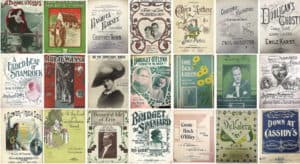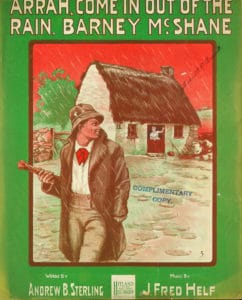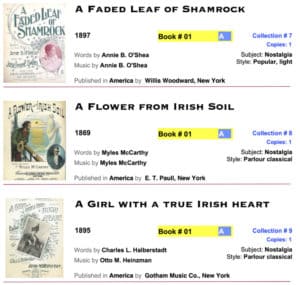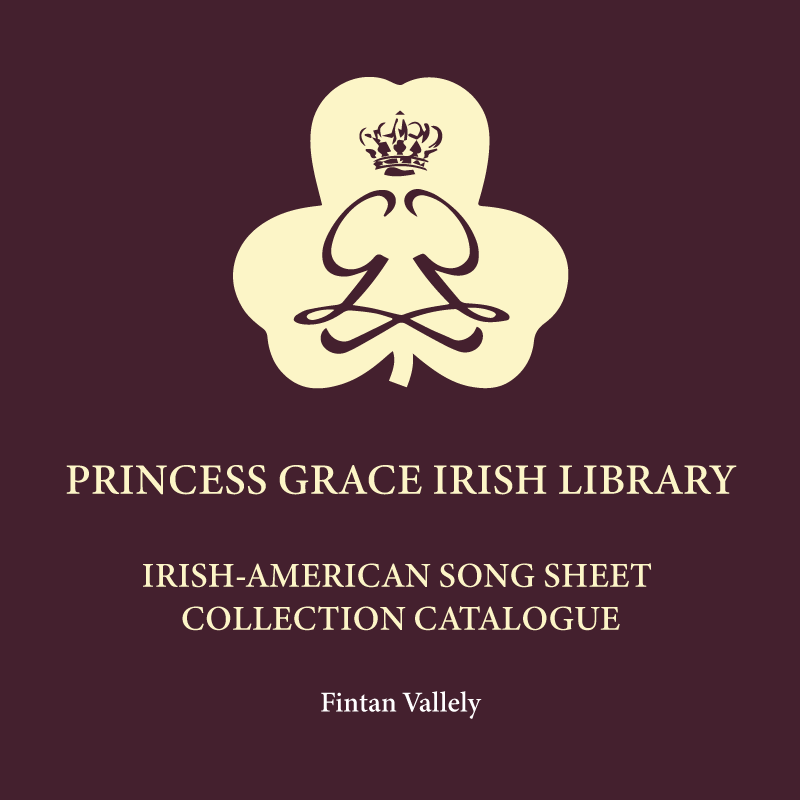Irish-American Song Sheet Collection Catalogue
The Princess Grace Song-Sheet Collection in Monaco
The Princess Grace
Irish-American Song-Sheet Collection
Catalogue
Researched and edited by
FINTAN VALLELY
2019
© Fintan Vallely and the Princess Grace Irish Library, Monaco, 2020
Genesis of the Princess Grace Song-Sheet Collection
The collection is an archive of printed song-lyrics and music from the years c. 1840-1940. These were designed for home and public entertainment in the era before the advent of radio and recordings, a time when all music was necessarily ‘live’. Song-sheets were to music then as records and CDs became later. As a trend, however, the song-sheet persisted well into the era of public broadcast music and easily-available, ’78 rpm disc ‘records’, dying out only after WWII; tens of thousands of titles were issued over the course of a century and a half.
A personal archive of these was built up by Michael E. O’Donnell of Philadelphia in the early-to-mid twentieth century, and purchased by Irish-American-born Princess Grace of Monaco in 1978. In Monaco, the material was kept in an 18th-century, mahogany-veneer music-cabinet in the Palace, and later was moved to the Library. From time to time visitors might peruse the sheets, some out of curiosity and cultural interest, others for research. The Administrateur, Judith Gantley, occasionally drew on the better of the Collection’s graphics for illustration on promotional materials for Library events, but she felt - as did the Library’s Trustees - that more should be done with them.

The digitisation project
Thus the collection had been relatively dormant until 2008 when Judith Gantley opened it to Dr. Fintan Vallely while he was on an Ireland Fund Monaco residency at the Library. Taken by the graphics, he photographed all of the covers, and resolved to consider cataloguing them. In 2012, attention was given to the collection too by Dr. Axel Klein, whose assessment of its value resulted in the Library being granted an RISM Library signum ('MC-MCpgil'), denoting it as an institution which holds sources or materials related to the research of music. Five years later, in 2017, Judith Gantley initiated scanning of the sheet covers and updating of the typed information into a computer database. Coincidentally, the same year, Dr. Vallely also digitised the database information from his photographs and had started on working out a classification system. The ensuing communications, discussion and consensus resulted in his being invited by the PGILTrustees to spend a couple of weeks on site in early 2019 physically and digitally cataloguing the song-sheets.

The 2017-19 cataloguing
Starting from the Library’s computer listing, Vallely input all its information to a Filemaker software programme that he designed - a relational database via which the material could be sorted in any number of ways. This makes it possible to assess the geography, time-scale, scope and nature of the songs, and to print off various forms of index which can yield different kinds of information. Above all, it means that each sheet could be assigned a unique number, and be located easily. Achieving this demanded a fresh ordering of the song-sheets, so all were sorted by song-name A-Z, each of the alphabetic categories was itself sorted A-Z, and then the individual sheets were photographed. The sorted scores were then placed in individual, non-corrosive, clear polypropylene binder sleeves; each sleeve was labelled with a location number from the computer database. The sleeves were then bound together in ‘books’ of c. 48, each with a title page which lists its contents by name and number. Finally, the books were returned to the original music cabinet, placed in top-to-bottom, alphabetic order; the database catalogue is the graphic inventory of these materials.
Volume 1 of the catalogue
Volume 1 is the main catalogue, with colour images of each of the 1099 discrete sheets, alphabetically organised by the full song-title (including definite and indefinite article where it appears on the sheet). Along with the image are the names of songwriter and music composer/arranger, the year of publication, publisher and city and country of publication. Each of these entries also carries the book-number, the song’s code number, and the alphabetic grouping in which the song is - locational information which relates the catalogue database to the actual documents.
For research purposes, a total of seventeen other individual indexes were generated from the digital information. These order the song-sheets in different ways to highlight data such as gender and nationality of the lyricist and composer as deduced from their names, and also song style and subject as well as publisher information.
Elements and features of the Collection
The sheets are mostly of a standard size (c. 24cm wide by c. 31 high) printed on a single folded page which acts as their cover, with, typically, an extra two-page insert, or often with from four to six inserted pages. Since these were songs to be performed by a singer and/or a pianist, the sheets have the music notation for both piano and voice, with lyrics printed below the music, matched to it. The covers on the 1800s sheets are typically black on white, but on the 1900s material many are multi-coloured, often with striking text or graphics.
There are 1698 sheets, 599 of which are duplicates, meaning that there are 1099 discrete song-sheets. Among these, 695 have one copy, 274 have two identical copies, 86 have three copies, 27 have four, 15 have 5 and just one has 7. Among the 1099 individual song-lyrics, there are occasional duplicates in the form of different editions (51 in all), reducing the number of actual songs represented to 1048; several of these lyrics however have different music settings.
Overall, 1040 lyrics-writers are named, some of them having more than one song to their credit. The commercial music lyricists and composers of this period are generally assumed to be independent of nationality in their work. These were the ‘Tin Pan Alley’ writers of the early 1900s who drew on various palettes of ‘national’ characteristics - such as metaphor, allusion, melodic principles and themes - for the express purpose of appealing to, and making money from, various nations’ American city communities. The Princess Grace Collection is only a partial inventory of such commercial songwriting, however, for c. 10% of its material was actually published in England, many of those lyrics and melodies being already long established as Irish, not least on account of having been written by such as Thomas Moore (41 songs). Further, at least 368 of the songs (33%) and 232 of the music compositions (21%) can be, by surname, reasonably considered to be by Irish or Irish-origin writers; yet, of course, many of these were obviously writing for New York publishers. As for gender, 172 of the lyricists of the 1099 songs (16%) were female, as were 140 (13%) of the composers. But among these, Irish women were prominent - 36% of the female lyricists and 30% of the female composers overall have Irish names. Almost a thousand of the songs (91%) were published in America (some of these also in London). 856 of these (78% of the total) were published in New York, 658 of them (60% of all songs overall) only in that city, with the balance of 200 also published in such as Boston, Chicago, Cincinnati, Detroit and Philadelphia.

The songs’ content
The content of the songs tells us much too. For while all of them relate to Ireland and Irishness, a quick, initial (but by no means definitive) survey suggests that 360 of them (33%) deal with love, 90 (8%) with emigration and exile; Irish American society is the subject of 200 (18%) of them; there are 180 (9%) on Irishness per se, and 56 (5%) deal with Irish national political identity. Nostalgia is a feature of 18% of the songs, while a narrative structure is the dominant style in 33% of them. A comic or satirical approach is taken in 200 or more lyrics (c. 18%), all of those being on social aspects of Irish-American culture, politics, work and life. Irishness in these is somewhat ridiculed, especially in the earlier period, but it is romanticised in the latter part of the song-sheets’ era. The delivery style runs from ‘parlour-Classical’ in the earlier sheets to ‘light-Popular’ in the later ones.
Celebration
A formal launch of the catalogue was not feasible in 2019, but in March of that year some of the song sheets were selected by Dr. Vallely to be used as part of the programme for an inaugural evening of Irish music at the recently-restored Kelly House in Philadelphia, in partnership with the Center for Irish Studies at Villanova University with its director, Dr Joseph Lennon, and adjunct professor Susan Kelly von Medicus. A Monaco launch with music was to follow in March 2020, led by Fintan Vallely on flute, with sisters Maighread and Tríona Ní Dhómhnaill (song and piano), in a concert of selections drawn from the song-sheets for a Saint Patrick’s Day concert at the Princess Grace Irish Library. This had to be cancelled at the last moment on account of the Covid crisis, but an extract from it was run for St. Patrick’s Day in 2023, and the full programme performed for a seminar at Technological University, Dublin the same year.
Fintan Vallely, Dublin, February 2020; updated March 25th 2024

The Main Volume (Vol. 1)
This is the main catalogue, with colour thumbnail-images of each of the 1099 discrete sheets, alphabetically organised by the full song-title. Along with the image are the names of songwriter and music composer/arranger, the year of publication, publisher and city and country of publication. Each of these entries also carries the book-number, the song’s code number, and the alphabetic grouping in which the song is - locational information which relates the catalogue database to the actual bound and preserved documents. Each entry has also a rough estimate of the song style and lyric focus, as a pragmatic guide for consultation, rather than being a precise definition.
For research purposes, seventeen other individual indexes have been generated from the digital information. These order the song-sheets in different ways to highlight data such as gender and nationality of the lyricist and composer deduced from their names, song style and subject, and publisher information. Other categories will be added to the database so that the material can be analysed in different ways, such as by cover image, key words in the song titles, first lines of songs, etc. The song style and lyrics subject will also be refined, online, and a fully-digitised format of all sheets will be completed in 2021.
The Collection will be kept intact, as it is, and there is no plan to expand it.
Volume 2
Lyricists:
- Index 1/ All lyricists
- Index 2/ Female lyricists
- Index 3/ Male lyricists
- Index 4/ Irish-named lyricists and writers
- Index 5/ Irish-named lyricists and writers by gender
Music composers / arrangers:
- Index 6/ All music composers and arrangers
- Index 7/ Music composers and arrangers - female
- Index 8/ Music composers and arrangers - male
- Index 9/ Irish-named music composers and arrangers A-Z
- Index 10/ Irish-named music composers and arrangers by gender
Volume 3
Publisher information:
- Index 11/ Publishers A-Z, with country and city
- Index 12/ Publishers, by country and city A-Z
- Songs and their subject matter and style:
- Index 13/ Song titles A-Z, with subject and style
- Index 14/ Songs: by subject A-Z, with style
- Index 15/ Songs: by Style A-Z, with subject
- index 16/ Song titles by year
- index 17/ Lyrics writer and song title by year